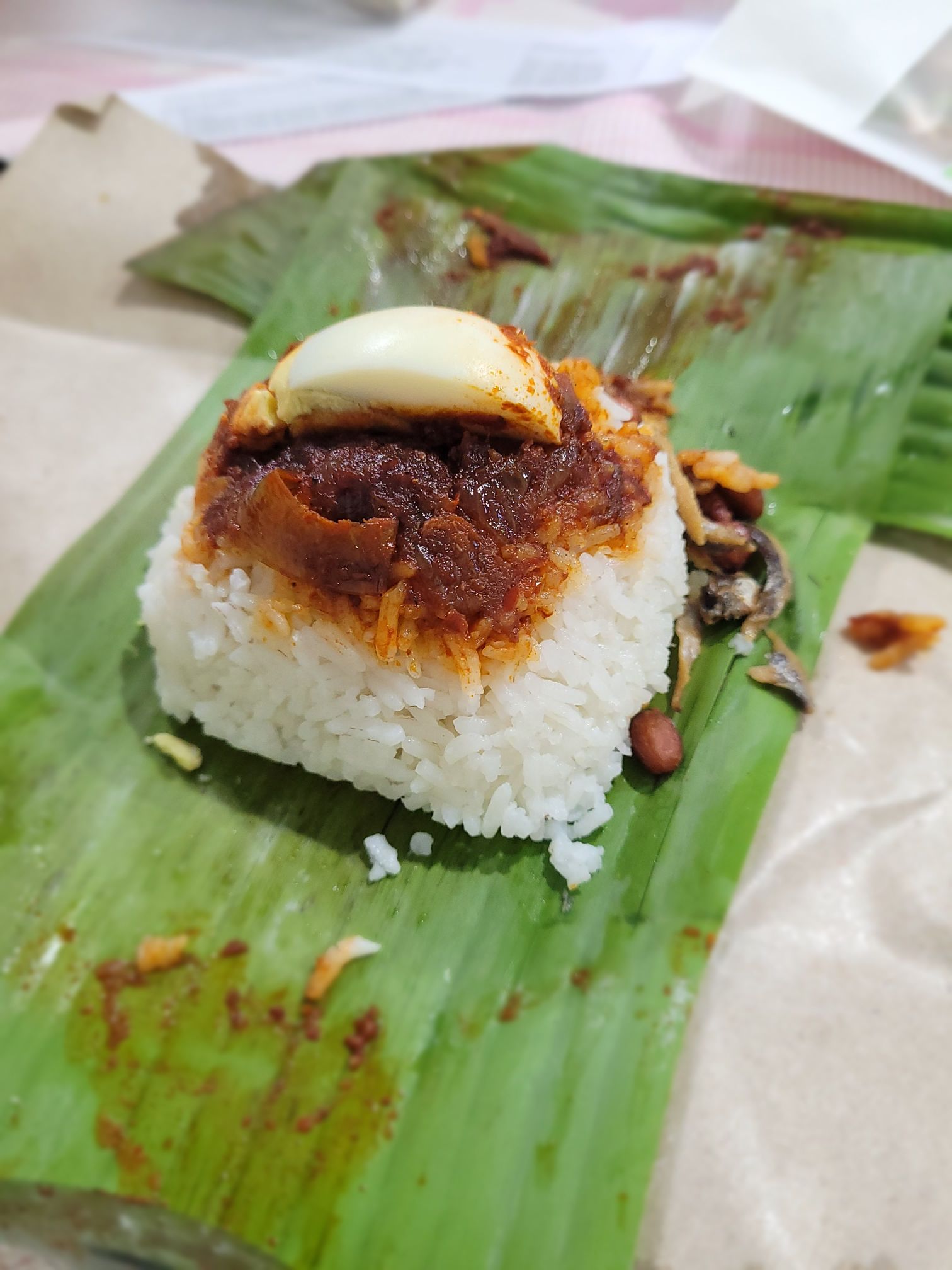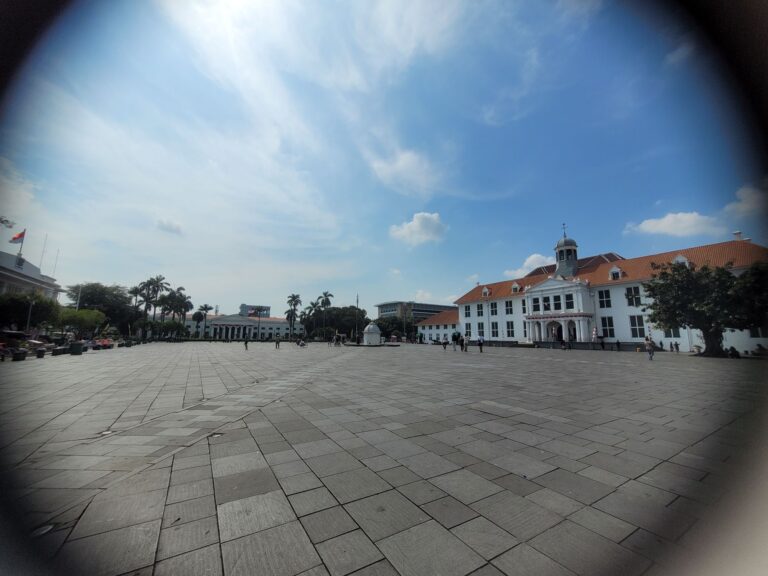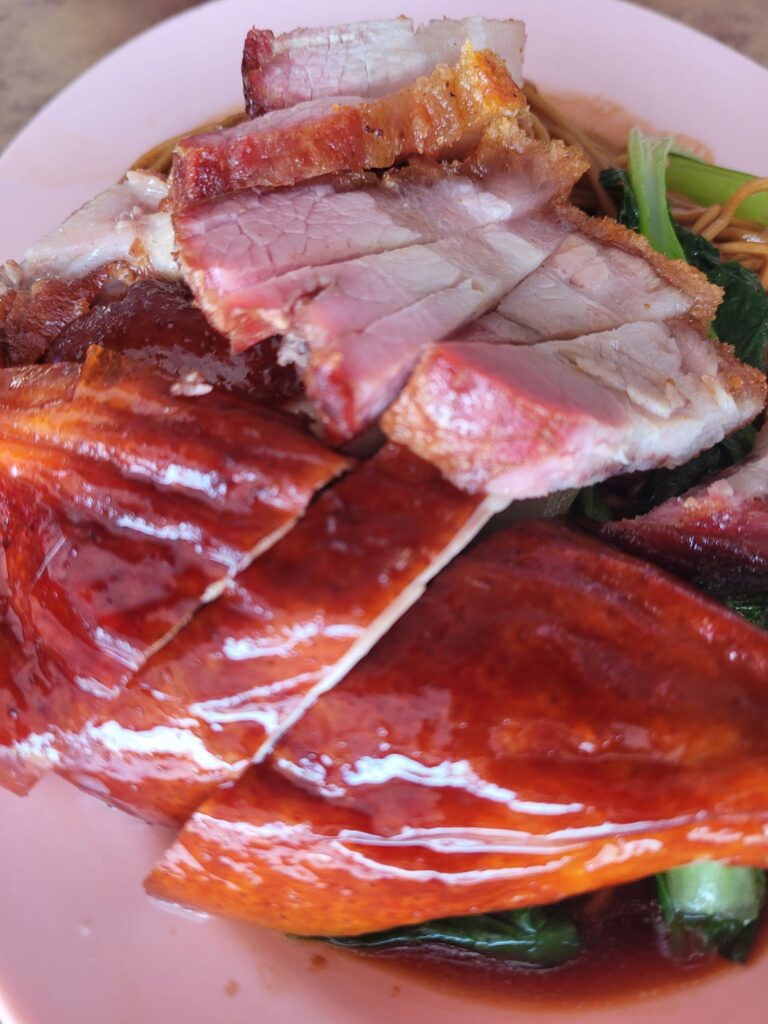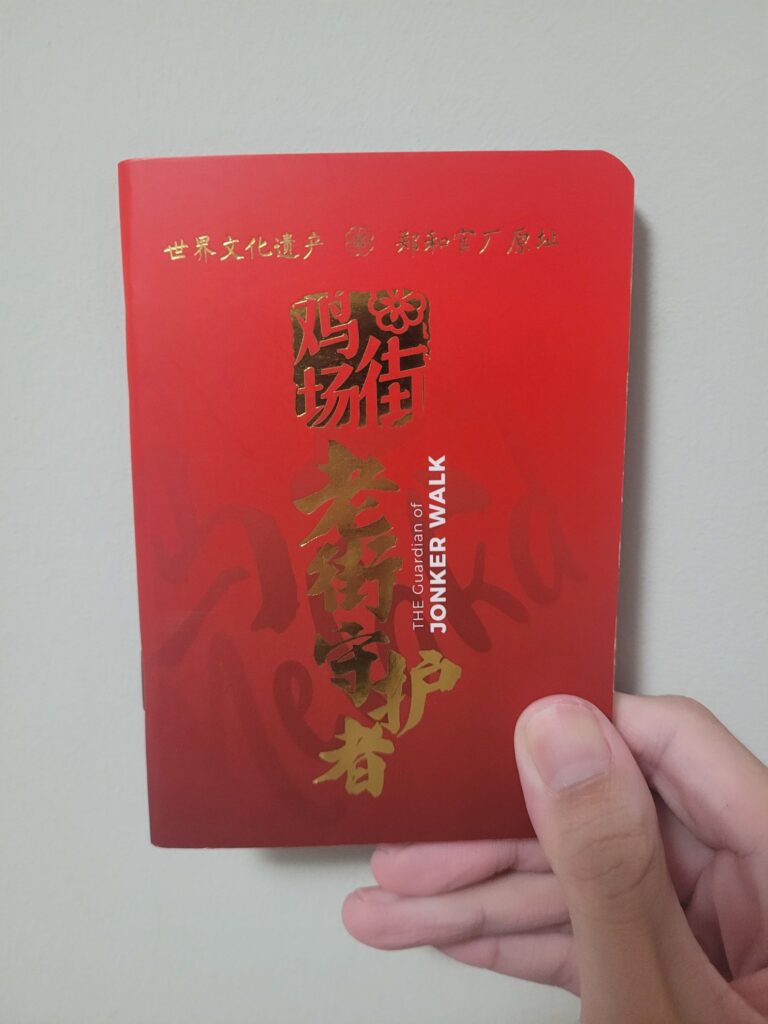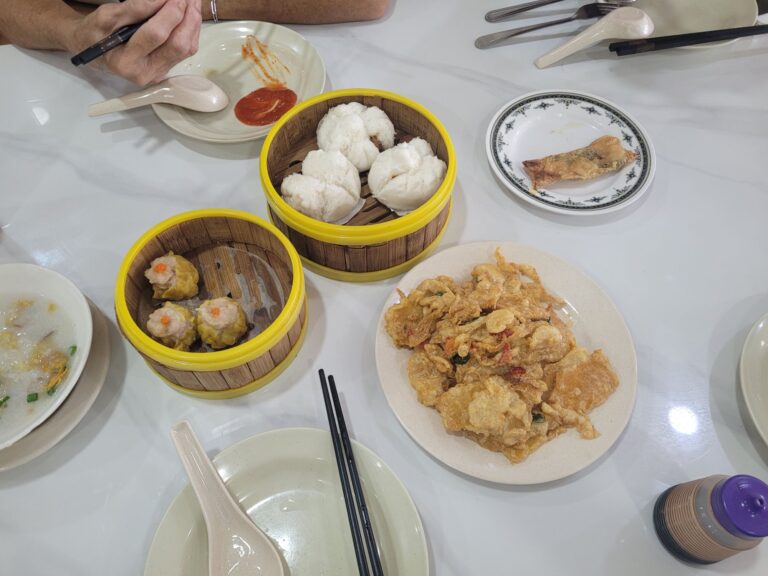Imagine this: you unwrap a warm, pyramid-shaped parcel of banana leaf. The first thing that hits you isn’t a sight, but a smell, a fragrant steam cloud carrying the sweet scent coconut, pandan, and a hint of ginger. Inside lies a mound of fluffy white rice, the heart of a dish that is so much more than a meal. It is a cultural touchstone, a morning ritual, and a soulful story on a plate. Welcome to the world of Nasi Lemak.
This beloved coconut rice dish is a staple across the Malay Archipelago, fueling cities like Kuala Lumpur and Singapore every morning. For the thoughtful traveler, to understand Nasi Lemak is to gain a deeper connection to the region’s heart, history, and incredible culinary soul. This guide will walk you through its rustic origins, break down what separates a good Nasi Lemak from a truly great one, and take you on a journey across borders to discover how this seemingly simple dish transforms from place to place.
📜 The Story of Nasi Lemak: From Farmer’s Fuel to National Treasure
Nasi Lemak’s story is woven from the land, the sea, and the daily lives of the people. Its exact origin is a matter of gentle debate, with several compelling theories painting a picture of its humble beginnings.
- Coastal Beginnings: One popular theory suggests the dish originated among the indigenous Malay communities living by the sea on the West Coast of Malaysia. In these villages, coconuts and anchovies – two core components of the dish – were abundant and readily available staples.
- Farmer’s Fuel: Another theory points inland, to the farmers toiling in the rice paddies. Nasi Lemak provided the perfect all-in-one meal, a powerhouse of nutrients with carbohydrates from the rice, fats and oils from the coconut milk, and protein from the anchovies and egg, giving them the sustenance needed for a long day of labor.
- The Urban Migration: As people moved from the countryside to the cities, they brought their food traditions with them. Nasi Lemak quickly became a go-to breakfast, sold at street-side stalls, or gerai, often run by women. They would wrap portions in banana leaf packets, known as Nasi Lemak Bungkus, creating a convenient, affordable, and utterly delicious way for everyone to start their day.
- A Unifying Dish: While its origins are distinctly Malay, Nasi Lemak has been wholeheartedly embraced by every culture in the region. Malay, Chinese, and Indian communities have all adopted the dish, each adding their own unique spin and side dishes. It stands as a powerful and delicious symbol of cultural harmony on a plate.
Beyond these practical origins, the dish is colored by charming folklore. A popular tale tells of a widow named Mak Kuntum and her daughter, Seri, in a village in Malacca. One day, Seri was cooking rice and accidentally spilled coconut milk into the pot. When her mother returned and smelled the fragrant aroma, she asked, “What did you cook, Seri?” The daughter replied, “Nasi le, mak!” (“It’s rice, mother!”), and thus, the name was born.
While its roots are in oral tradition, Nasi Lemak also has a documented history.
- The earliest known written mention dates to 1875, in a French-Malay dictionary by Pierre-Etienne-Lazare Favre.
- In 1909, British administrator and scholar Sir Richard Olaf Winstedt described it in his book The Circumstances of Malay Life, noting how “the Malay cook” would boil rice in coconut milk (masak lemak) for festivals and wedding feasts.
Traditionally, Nasi Lemak was a breakfast staple, wrapped in banana leaves and, by the 1970s, sold door-to-door by hawkers. This simple, satisfying meal has since evolved into a dish enjoyed at any time of day, a true culinary icon.
❤️ The Anatomy of a Perfect Nasi Lemak: What to Look For
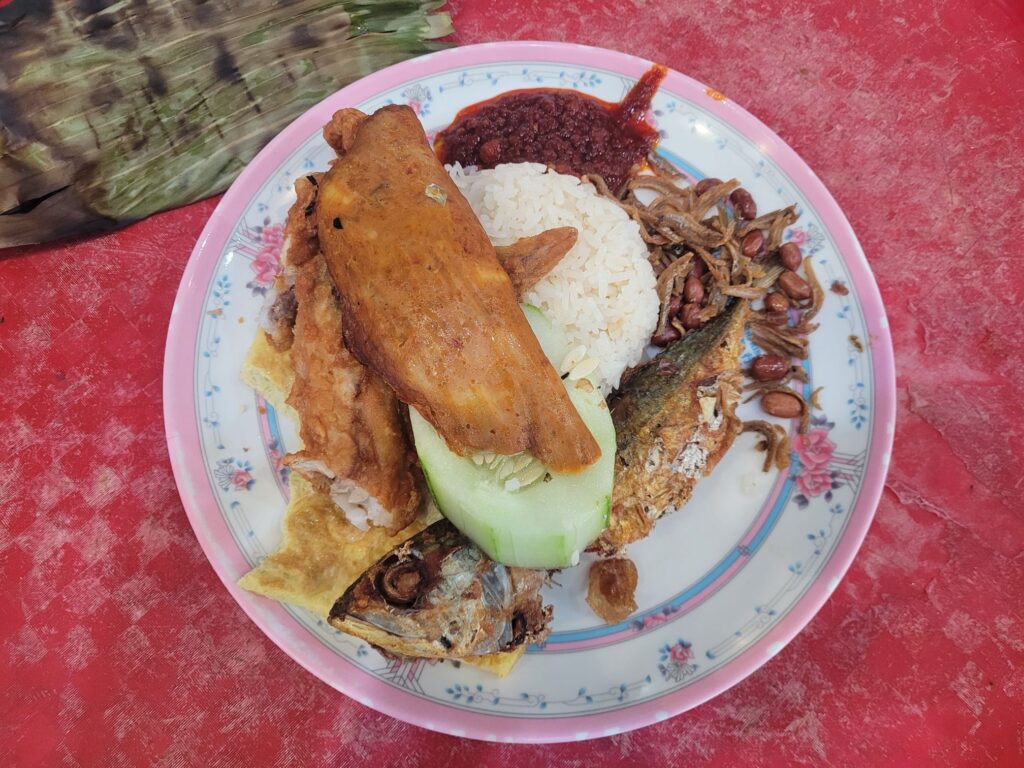
Like any iconic dish, the magic of Nasi Lemak lies in the quality of its individual components. A truly great Nasi Lemak is an exercise in balance, where every element is crafted with care. Here’s what separates the mediocre from the memorable.
1. The Coconut Rice (Nasi): The Heart of the Matter
- The name “Nasi Lemak” literally translates from Malay to “fatty rice” or “rich rice.” But “lemak” is a culinary term that goes beyond just fat; it describes a specific kind of savory richness, a creamy and luxurious mouthfeel that is central to the cuisines of the region. The name is a direct and honest description of the rice, which is the star of the show.
- What it is: Long-grain rice gently steamed with fresh coconut milk, knotted pandan leaves, and often a bruised stalk of lemongrass and a slice of ginger for extra fragrance. In more elaborate versions, you might find whole spices like fenugreek seeds, cinnamon, cloves, or star anise.
- What Makes It Great: Perfection in the rice is non-negotiable. The grains should be light, fluffy, and distinct, never mushy, wet, or oily. To achieve this, some cooks use steaming methods or even pre-fry the raw rice grains. You should be able to taste and smell the coconut milk, but it should be a clean, savory flavor, not a heavy, cloying one. The aroma from the pandan is the signature scent that makes it instantly recognizable. A sign of true quality is when the rice is so good, you could happily eat it on its own.
- Color: While traditionally white, modern Nasi Lemak has become a canvas for color. You may find Nasi Lemak Kuning (yellow from turmeric), vibrant blue versions using butterfly pea flowers, or green rice infused with extra pandan juice.
2. The Sambal: The Soul of the Dish
If the rice is the heart, the sambal is the soul. A Nasi Lemak without good sambal is incomplete.
- What it is: A complex chili paste that is arguably the most important element, capable of making or breaking the entire dish. It is a slow-cooked blend of dried chilies, fresh shallots, garlic, ginger, tangy tamarind paste, and the deeply savory, funky note of belacan (fermented shrimp paste). Some recipes blend fried anchovies directly into the sambal for an extra layer of savory depth.
- What Makes It Great: A great sambal has a deep, dark brownish-red color, which indicates it has been cooked low and slow until the oil separates (pecah minyak). This is when the chili paste is cooked slowly over low heat until the oil separates and rises to the surface. This technique is vital, it means the sambal is fully cooked, its flavors have melded perfectly, and it won’t have a raw, bitter taste. This process mellows the raw heat of the chilies and melds the ingredients into a harmonious whole. The flavor should be a multi-layered explosion: spicy, of course, but also sweet (from palm sugar), tangy, and profoundly savory. It should be a rich, thick paste, not a watery sauce.
3. The Essential Accompaniments: The Perfect Crunch and Contrast
These are the supporting actors that complete the ensemble, providing crucial texture and contrast.
- Ikan Bilis Goreng (Fried Anchovies) & Kacang Goreng (Roasted Peanuts): These are the textural superstars. Tiny, dried anchovies are fried until golden, and peanuts are roasted to perfection. Their greatness lies in one single quality: crispiness. They provide the essential salty, savory, nutty crunch needed to contrast with the soft rice and the spice of the sambal. Soggy anchovies or stale peanuts are a cardinal sin in the world of Nasi Lemak.
- Telur (Egg) & Timun (Cucumber): These elements provide balance and freshness. Traditionally, a simple hard-boiled egg cut in half is used. A modern and very popular variation is a fried egg (telur mata), often served with a perfectly runny yolk that mingles beautifully with the rice and sambal. Cool, fresh slices of cucumber offer a refreshing, hydrating contrast that balances the heat and richness of the other components. In some regional variations, blanched kangkung (water spinach) might be used instead.
🌍 One Dish, Many Faces: How Nasi Lemak Changes Across Borders
This is where the true adventure begins. Nasi Lemak is a living culinary language with countless dialects. Here’s a deep dive into how it is spoken across the region.
🇲🇾 Malaysia
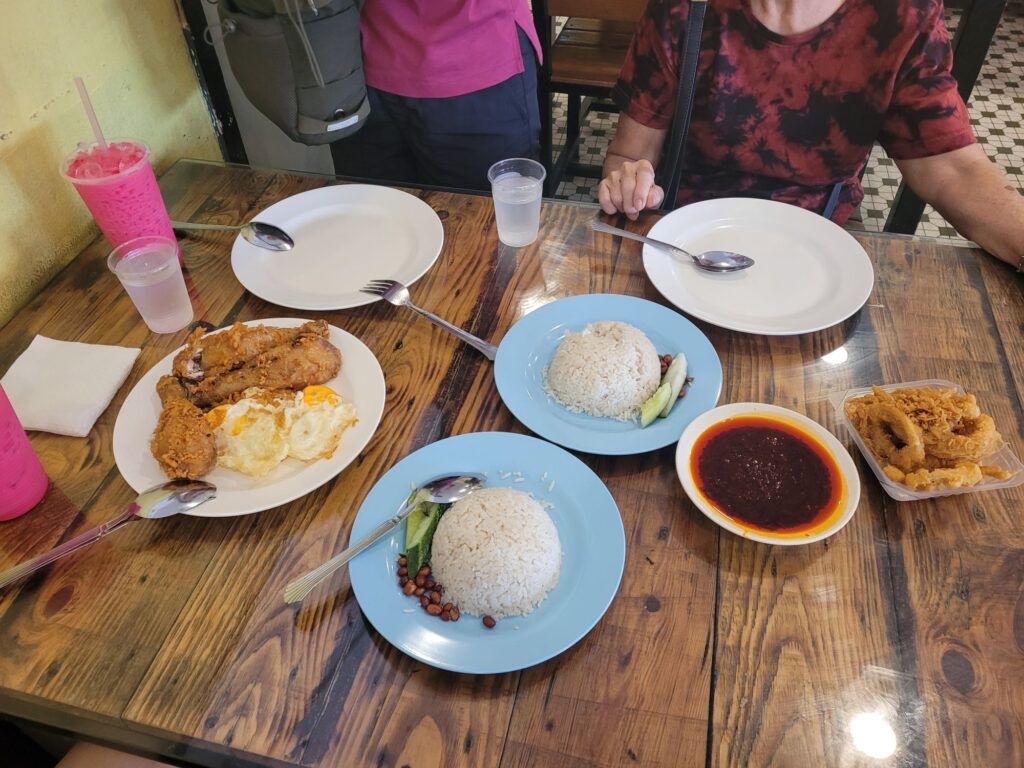
In Malaysia, Nasi Lemak is more than just food; it’s a unifying cultural symbol. While the standard version is beloved, the country is a treasure map of regional specialties.
The Sambal: The sambal here is typically a sambal tumis that strikes a powerful, robust balance between spicy and savory, with a distinct funk from the belacan and a subtle sweetness from palm sugar. It’s unapologetically bold.
General Accompaniments & Modern Twists:
Beyond the basic set, the dish becomes a canvas for a vast array of side dishes.
- The Sides: The classic Nasi Lemak Biasa (basic) is the foundation. However, the true joy lies in the add-ons, which are usually traditional Malay dishes:
- Beef Rendang: A rich, slow-cooked dry curry where beef becomes incredibly tender and infused with a complex spice paste.
- Ayam Goreng Berempah: Spiced fried chicken, marinated in a fragrant blend of lemongrass, turmeric, ginger, and galangal before being deep-fried to crispy perfection.
- Sambal Sotong: Cuttlefish cooked in a thick, rich sambal, adding a chewy texture and seafood flavor.
- Paru Goreng: Fried beef lung, a delicacy for the more adventurous, sliced thinly and fried until chewy and crisp.
- Vendor Signatures: Some famous stalls offer both spicy and non-spicy sambal and signature dishes like ayam masak merah (chicken in red chili sauce), prawn sambal, or anchovies stir-fried with petai (stink beans).
- Healthier Versions: You can now find Nasi Lemak made with brown rice for a healthier, though less traditional, option.
Regional Variations within Malaysia:
- Johor (Nasi Lemak Halba): This Southern version incorporates fenugreek seeds (halba) into the coconut rice, giving it a unique, slightly bitter, and aromatic flavor. It’s often served simply with a standard sambal tumis.
- Kedah (Nasi Lemak Kuning / Royale): Known as “yellow nasi lemak,” it gets its signature color from turmeric cooked with the rice. This variant often includes more herbs and spices, resulting in a denser flavor that pairs beautifully with ayam goreng berempah (spiced fried chicken).
- Terengganu: On the East Coast, this variant often features flapjack tuna (ikan tongkol) cooked into the sambal instead of anchovies. The sambal itself is frequently sweetened with local gula nisan (palm sugar) for a richer, deeper taste.
- Kelantan (Nasi Lemak Tumpang): A truly unique form, this Nasi Lemak is layered with rice and various dishes (like fish floss or tuna gulai) inside a tightly packed banana leaf cone. The compression gives the rice a soft texture similar to nasi impit (compressed rice cake).
- Malacca: Here, it’s common to find blanched kangkung (water spinach) served alongside or in place of cucumber, a subtle but distinct local preference.
- Malaysian Chinese Version: A non-halal variation found in cities like Penang and Kuala Lumpur might include pork dishes. It also often features a sweeter chili paste and sides like luncheon meat.
- Malaysian Indian Version: This version is often served with rich, flavorful sides from South Indian cuisine, such as chicken masala, lamb curry, or chicken varuval (a dry-fried dish).
- Strawberry Nasi Lemak: A quirky specialty from the Cameron Highlands, where strawberries are blended into the sambal and the rice is colored pink, creating a surprising sweet-spicy-savory fusion.
🇸🇬 Singapore
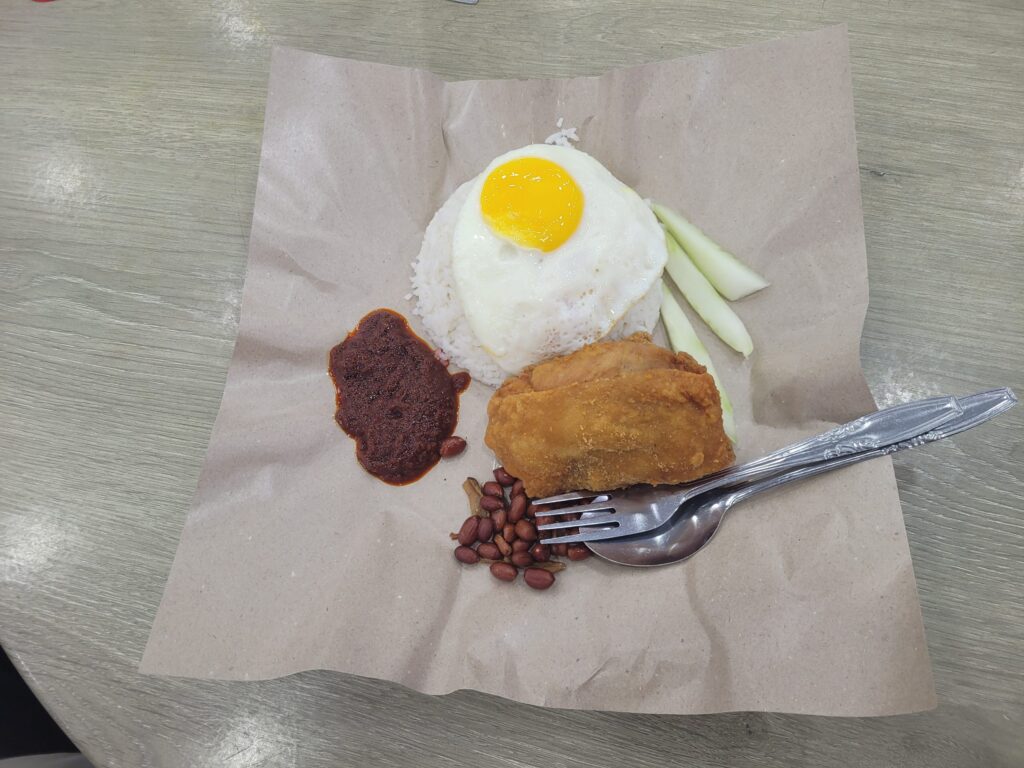
Nasi Lemak is a quintessential dish in Singaporean food culture, enjoyed at all hours. While sharing its core with Malaysia, it has developed its own distinct personality.
- The Singaporean Sambal: A key difference is the sambal, which is typically sweeter and less spicy than many Malaysian versions, a characteristic that appeals to a wide range of palates.
- The Chinese Variant: This is the most prevalent style in Singaporean hawker centres. The plate is often loaded with a variety of accompaniments:
- A deep-fried chicken wing or drumstick
- Fried ikan kuning (small yellowtail fish)
- Chicken franks or luncheon meat
- Fish cake
- An omelette (often favored over a hard-boiled or fried egg)
🇮🇩 Indonesia
Nasi Lemak is native to parts of Sumatra and shares a common heritage with Malaysia. However, Indonesia is home to several very similar dishes with their own distinct names and traditions.
- Nasi Uduk (from Jakarta): This is Jakarta’s signature coconut rice. The rice itself is often more aromatic, cooked with lemongrass, Indonesian bay leaves (daun salam), and sometimes galangal. The most significant difference is the condiment: it is not served with a cooked chili sambal. Instead, it is usually accompanied by a creamy peanut sauce (sambal kacang) or a fresh, raw chili relish (sambal terasi). Common side dishes include fried shallots, shredded omelet, sweet soy-glazed tempeh (tempeh orek), and fried chicken.
- Nasi Gurih (from Aceh, Sumatra): Meaning “savory rice,” this version from the northern tip of Sumatra is also cooked with coconut milk and spices. It is served with its own distinct set of Acehnese side dishes and sambals, reflecting the region’s unique culinary identity.
- Nasi Gemuk (Jambi & Palembang): In these Sumatran provinces, a nearly identical dish is known as Nasi Gemuk, where gemuk (fat) is a local synonym for lemak.
- Riau Islands: As an archipelago, it’s no surprise that seafood is the star here. Nasi Lemak is a popular breakfast, commonly served with local fish like ikan tamban (sardines), squid (sotong), or shrimp.
- Pekanbaru (Riau): In this part of Sumatra, freshwater river fish like ikan selais (catfish) or ikan patin are popular accompaniments. They might be cooked in Minang-style lado ijo (green chili sauce) or simply fried.
- Medan (Medan Melayu Deli): This version is a feast on a plate. It’s typically served with a choice of beef or chicken rendang or balado (chili-fried egg or shrimp). The plate is then loaded with an incredible array of textures and flavors:
- Crispy fried shallots
- Slices of omelette
- Kripik kentang balado (spicy, caramelized potato chips)
- Tempe orek (sweet soy-glazed fried tempeh)
- Perkedel (fried potato patties)
- Slightly bitter emping crackers
🙏 How to Eat Nasi Lemak Like You’ve Done It a Thousand Times
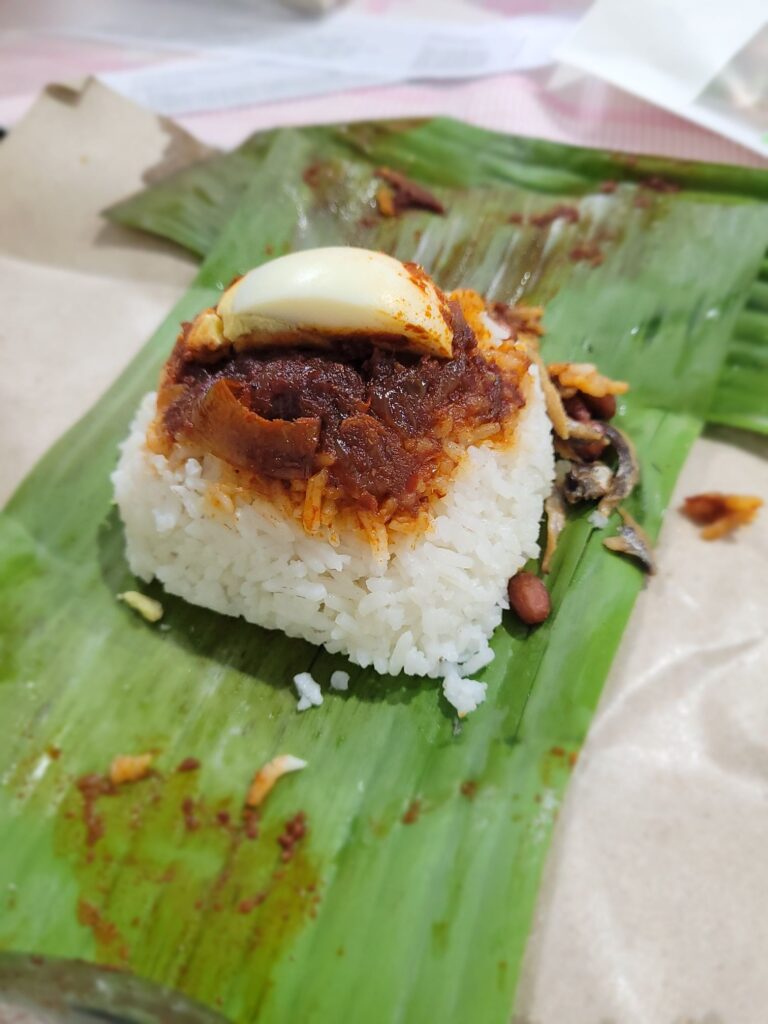
Observing the local customs can deepen your travel experience, turning a simple meal into a cultural connection.
The “Bungkus” Experience: If you get your Nasi Lemak wrapped in a banana leaf, take a moment to appreciate the ritual. The leaf isn’t just a wrapper; it’s an ingredient. As you unfold the packet, the steam that escapes carries the subtle, earthy aroma of the leaf, which has gently infused the warm rice. This is a sensory experience you miss when it’s served on a plate. It’s still my favorite form of nasi lemak to enjoy, simple, yet delicious.
The Art of the Perfect Bite: The key to enjoying Nasi Lemak is to experience all its flavors and textures in harmony. Don’t eat each component separately. Use your spoon to gather a little bit of everything in a single mouthful: a scoop of the fluffy rice, a smear of the rich sambal, a few crunchy anchovies and peanuts, and a piece of egg. This is how you taste the dish as it was intended, a perfect, balanced symphony.
Hands or Utensils?: While a spoon and fork are always available and perfectly acceptable, in many local eateries, you’ll see people enjoying Nasi Lemak the traditional way: with their right hand. This tactile way of eating is believed by many to make the food taste better. If you choose to try, use only the fingertips of your right hand to mix the rice and sambal and bring it to your mouth. Whichever method you choose, do it with confidence and enjoy the experience.
A random thought: Look at the same plate of Nasi Lemak after different people have eaten it – you’ll see different combinations of leftovers, be it the chili, the cucumber or chicken skin.
✨ The Modern Evolution of Nasi Lemak
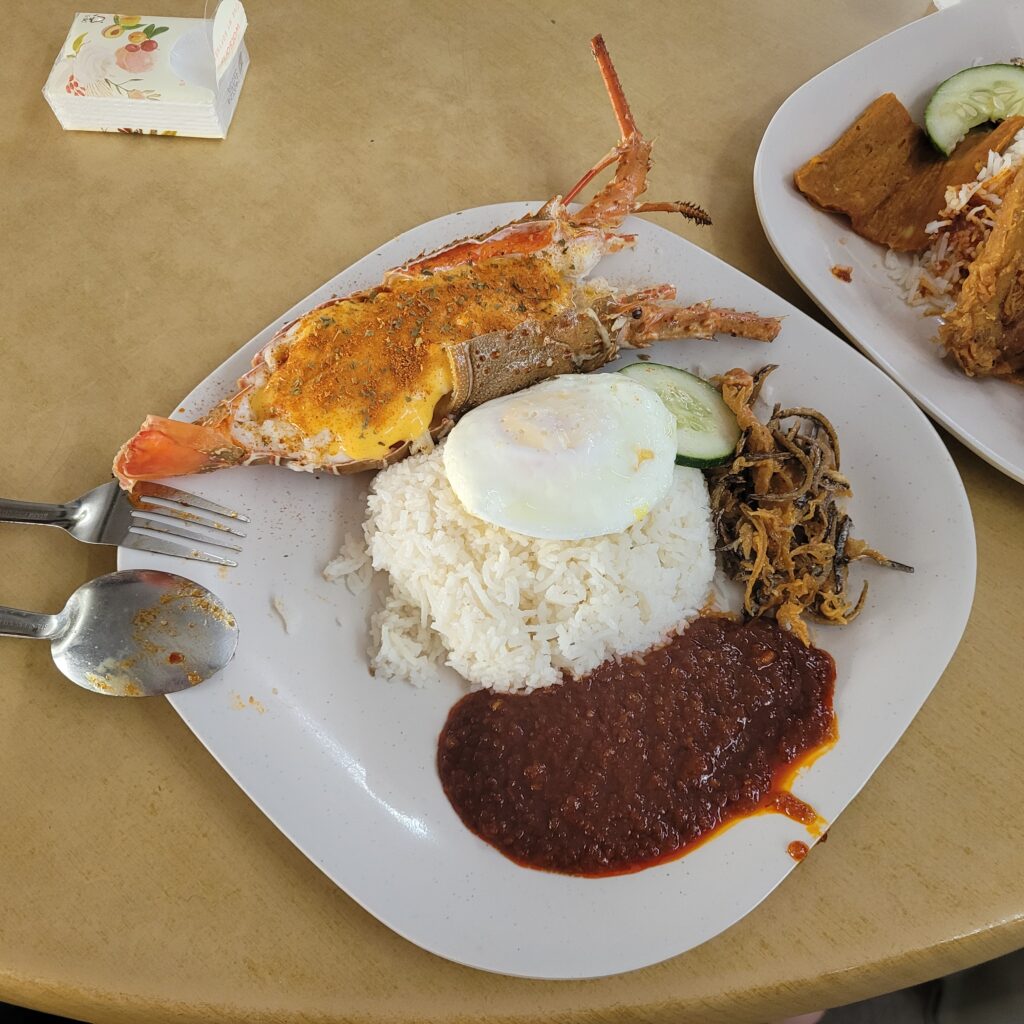
Nasi Lemak is a living tradition, constantly evolving. Creative chefs and entrepreneurs have taken the classic flavor profile and adapted it into new and exciting forms. You can now find Nasi Lemak burgers (McDonald’s has a seasonal variation here in Singapore), pizzas, and even Nasi Lemak-flavored ice cream. These modern twists are a testament to the dish’s beloved status and its ability to inspire culinary innovation (I would say interesting to try but nothing can beat the original). More stores are also adding more interesting sides to the dish – anyone tried Nasi Lemak with lobster before?
❓ Frequently Asked Questions (FAQ)
Is Nasi Lemak always spicy?
The rice itself is savory and fragrant, not spicy. The heat comes entirely from the sambal. If you’re sensitive to spice, you can always ask for the sambal to be served on the side (“sambal asing“) or for just a small amount.
Is it only a breakfast food?
Traditionally, it was a breakfast dish. Today, however, its popularity is so immense that you can find it at any time of day, for breakfast, lunch, dinner, and even as a late-night supper.
I am a vegetarian. Can I eat Nasi Lemak?
A classic Nasi Lemak is not vegetarian because of the ikan bilis (anchovies) and the belacan (shrimp paste) used in the sambal. However, many restaurants and vegetarian stalls now offer excellent vegetarian versions. They typically replace the anchovies with fried soy bits or mushrooms and use a shrimp-paste-free sambal, served with tofu or vegetable-based side dishes.
Where is the best place to try it?
The “best” Nasi Lemak is a passionate and endless debate! For the most authentic, no-frills experience, try a busy morning street stall where you see a long line of locals, that’s always a good sign. For a more comfortable setting with a wider variety of side dishes, a local cafe (kopitiam) or a specialty restaurant is a great choice. Part of the travel adventure is discovering your own personal favorite. But, if you want my personal recommendations, I will cover it more in detail in another blog post someday.
📚 Further Exploration: Dive Deeper into the World of Nasi Lemak
- Wikipedia – Nasi Lemak: An excellent starting point for a comprehensive, encyclopedic overview. This entry covers the dish’s history, etymology, ingredients, and various forms across different countries.
- Roots.gov.sg – Nasi Lemak (Singapore National Heritage Board): This resource provides a fascinating insight into Nasi Lemak’s status as an Intangible Cultural Heritage in Singapore. It delves into its cultural significance within Singaporean society, highlighting how the dish contributes to local identity and shared heritage.
- Science Meets Food – The Tale of All-Time Malaysian Favorite Dish Nasi Lemak: For those who appreciate a unique perspective, this article explores Nasi Lemak from a scientific viewpoint. It discusses the nutritional aspects and the fascinating chemistry behind why certain ingredients work so harmoniously together, offering a fresh way to appreciate the dish’s culinary genius.
- Michelin Guide – What is Nasi Lemak: This piece offers insights into Nasi Lemak from a renowned culinary perspective, often focusing on the nuances of a high-quality dish and specific vendors. It’s particularly useful for travelers seeking out exceptional versions of the dish and understanding the gastronomic appreciation of Nasi Lemak within Singapore’s vibrant food scene.
Conclusion
Your Nasi Lemak adventure awaits. Be bold, be curious, and be ready to share in a ritual that millions enjoy every day. This is far more than just a plate of coconut rice; it’s a story of history, culture, and the art of finding perfection in simplicity. Make sure you find a chance to try one of my favorite dishes whether you find yourself in Singapore or Malaysia.
What’s the most interesting side dish you’ve tried with your Nasi Lemak? Share your favorite spots or any questions you have in the comments below!
If this deep dive into Nasi Lemak has whet your appetite for more, we invite you to explore our full section on Food Culture, where we uncover the heart of cuisines from around the globe

